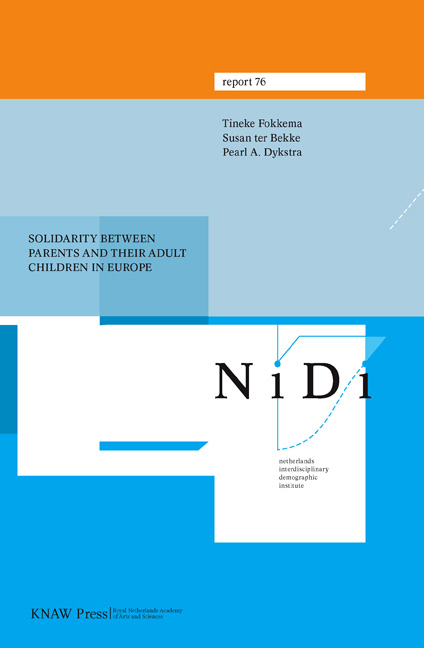Book contents
- Frontmatter
- Contents
- List of Figures
- List of Tables
- Executive Summary
- Acknowledgement
- 1 Introduction
- 2 Geographical Proximity
- 3 Contacts
- 4 Family Care Obligations
- 5 Support Exchange
- 6 Typology of Late-Life Families
- 7 Conclusion and Discussion
- References
- Appendix Measurement of the Independent Variables
- List of NIDI Reports
1 - Introduction
Published online by Cambridge University Press: 20 January 2021
- Frontmatter
- Contents
- List of Figures
- List of Tables
- Executive Summary
- Acknowledgement
- 1 Introduction
- 2 Geographical Proximity
- 3 Contacts
- 4 Family Care Obligations
- 5 Support Exchange
- 6 Typology of Late-Life Families
- 7 Conclusion and Discussion
- References
- Appendix Measurement of the Independent Variables
- List of NIDI Reports
Summary
Background
In the second part of the last century, major demographic and socioeconomic transformations have been taking place in Europe. The most notable demographic change is the ageing of Europe's populations, as a result of the transition from relatively high to low fertility and increased life expectancy. Other important demographic changes are: postponement of leaving the parental home (especially in southern Europe), delayed partnership/marriage and parenthood, increases in childlessness (projected in parts of Europe) and increases in union dissolution (e.g. Aassve et al., 2002; Allan et al., 2001; Billari et al., 2001; Hakim, 2000; Kiernan, 2004; Kuijsten, 1999; Liefbroer, 2005). On the socioeconomic front, the most notable changes are: the expansion of education, the development, expansion and adaptation of welfare systems (including social protection, pension and early retirement schemes, provision of state care support), and the massive influx of women into the paid labour force. Along these transformations, Europe faced broader societal changes, like the processes of individualisation and secularisation, increasing geographic mobility, women's emancipation, and changing care preferences (Lesthaeghe & Surkyn, 1988; Van de Kaa, 1987).
These transformations have resulted in irreversible changes in household size and composition (Fokkema & Liefbroer, 2007; Hall, 1986; Keilman, 1987, 2005; Kuijsten, 1995). There is a trend throughout much of Europe towards smaller households. One-person younger households are on the rise: besides increases in union dissolution, an increasing number of young adults establish premarital residences independent of their parents as the final step in their transition to adulthood. The proportion of one-person households among the elderly has increased as well, due to a combination of rising prosperity, increased life expectancy, growing popularity to live independently as long as possible, and increased state-provided elderly care and support. The decrease in the number of children per family and smaller age gaps between each child have led to a narrowing of the time frame during which one is responsible for dependent children, although the expansion of education and postponement of leaving the parental home postpone the ‘empty nest stage’. Furthermore, because of the changing roles of women and men in society, a trend is noticeable regarding the organisation of tasks within the household. While for a long time it was common that the husband was the only or main breadwinner and the wife was responsible for child care and housework, the division of tasks is currently less clear.
- Type
- Chapter
- Information
- Publisher: Amsterdam University PressPrint publication year: 2008



